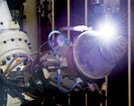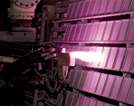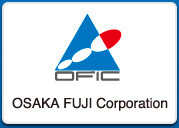OSAKA FUJI Corporation undertakes contracts for slicing silicon wafers for photovoltaic cells and a variety of other materials. We use wire saws and a variety of other equipment in order to proactively respond to customer needs for processing valuable materials with high yield and low kerf loss in everything from continuous manufacturing for mass production to lot and job production for research and development. Contact OSAKA FUJI Corporation if you are struggling with costs and yield related to slicing on the manufacturing and development worksite.
What is a multi-wire saw?
In a multi-wire saw, work material is attached to a top plate and is sliced as it is lowered through the wire blades. As a tool, the saw is comprised of anywhere from several hundred to over one thousand ultra-fine steel wires with a diameter of 0.2 mm or less, which are passed through grooves etched into guide rollers. slicing operation is performed by setting product thickness using the pitch of the guide roller grooves and then operating the saw at high speed while applying cutting liquid and pressing the work material slowly against the saw. In this process, only parts where the wire is routed are cut, and it possible to simultaneously slice out a number of products corresponding to the number of times the wire has been wound around the machine. A schematic diagram is provided below.
There are currently two slicing methods: fixed abrasive slicing and loose abrasive slicing. *Details provided below.

What is slicing?
Fixed abrasive slicing
Fixed abrasive slicing is a slicing method in which a wire to which diamond abrasive particles or a similar material has been chemically bonded (by means of nickel plating or resin bonding) is run at high speed. The cut is made by pressing the work material against the wire while coolant (cutting liquid) is applied.

Loose abrasive slicing
Loose abrasive slicing is a slicing method in which slurry (a suspension of abrasive particles, water, oil, and other materials) is applied to a wire running at high speed. The work material is pressed against the wire, and the cut is made by the rolling motion of abrasive particles between the wire and the work material.

OSAKA FUJI Corporation has a proven track record in slicing process silicon ingots for photovoltaic cells, quartz components, and sintered items using multi-wire saws.

Silicon wafers for photovoltaic cells

Quartz glass
Details of multi-wire saw slicing process
| Item | Description |
|---|---|
| Slicing characteristics | High-efficiency slicing improves material yield and makes it possible to process large numbers of materials in a single slice. Furthermore, as it is a cold process, it also provides the advantage of being largely unaffected by processing heat. |
| Example work materials | Can be used with silicon, quartz, sintered items, ceramics, superhard alloys, and metal materials with extremely poor workability. |
| Approximate dimensions of work material | Width (max. 160 mm) x height (max. 160 mm) x length (max. 450 mm) *Exact dimensions differ depending on machine. Contact us for details. |
| Approximate weight of work material | Max. 20 kg |
| Product shape | Plate (Direct cut in one direction) |
| Product precision | Thickness: 120 μm or more, Surface roughness: approximately Ra= 0.5 μm (based on actual results of sliced silicon) *Details considered upon separate consultation. |
The above details are only one example of what we can produce. Contact OSAKA FUJI Corporation regarding shape, size, materials, and other details.
![]() Frequently asked questions related to our R&D(Slicing Process).
Frequently asked questions related to our R&D(Slicing Process).
- Do you accept requests for prototype/mass production for slicing process projects from outside Japan?

- Do you sell machinery and equipment for wire, multi-wire saws, and the like?

![]()










